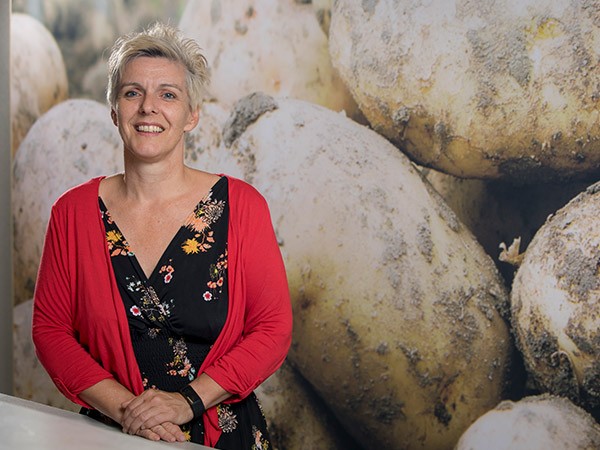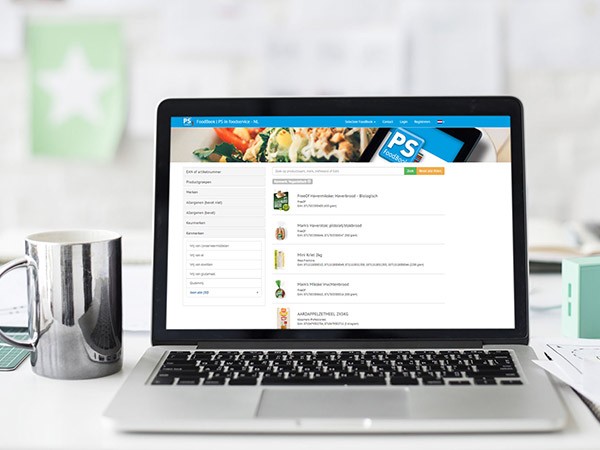
Food products consist of ingredients that have a combined value. Nutritional value, of course, there is more. Such as the emotional value and CO2 value. For the creation of value, marketing and transparency, reliable product information is essential. And that is where PS in food service, that has existed for 10 years now, comes in.
Not only flavour, colour, smell and bite of food give products their emotional value; it is where the ingredients come from can also be of great influence. And what do you think of leaving out ingredients: less or no salt, sugar, allergens and/or preservatives add much to the value of a product. If this value is high, the product will go down on the ladder of ‘socially desirable’. More and more processors and sellers of foodstuffs want to be able to inform their customers on this. In some cases they are even obliged to do so. Nicole Kleuskens, who started PS in food service in 2009, knows all about it.
‘Food service had to process too much generic information, there were poles of paperwork all the time. Wholesalers all used the same forms for their suppliers. These all had to fill in these forms by hand, after which the wholesaler copied the data for their own database. Not very convenient or clear. We decided to collect the data centrally and digitise the source files. The reactions were immediately positive, there proved to be a need for this. At the end of 2014 PS in food service was given an enormous boost: new European legislation obliged entrepreneurs to provide consumers with allergen information. The information must be directly available when a guest or consumer asks for it. This meant that an up-to-date, reliable database became a requirement, for which we had already laid a solid foundation. Through the years, the programme was expanded further, as more and more information was demanded: think of origins, certificates and the story of the product, but also being able to see photos and recipes for inspiration. Food service is a leader in the recording of all these data. Giant steps are taken in this industry.’
‘Some 23,000 are processed in PS every month’

‘Partly thanks to the PIANOo guidelines. The government demands of the food service that it purchases in a socially responsible way. PIANOo, the Tendering Expertise Centre of the ministry of Economical Affairs and Climate, is responsible for professionalising these purchases and bids at all levels of administration. So bids have a mandatory framework in this branch; it is sharply monitored what you offer as a caterer, how healthy and sustainable your assortment is and what actions you undertake to make your assortment even more healthy and sustainable. This makes it part of their distinctive capability. In turn, food service demands from their suppliers that sufficient additional information is available, so they can prove that they meet the PIANOo requirements.
By providing product information in an organised way, we support wholesalers and food service in making the healthiest choices. At the moment we are expanding our search system, which makes choosing even easier for them. They can make fine-tuned searches for products that are high in fibres, for instance, or low in salt.’
‘GS1 focuses on supermarkets. Worldwide it is the only organisation that is allowed to issue bar codes. Originally, the target group of PS is the food service. We give transparent product information of food, beverages and non-food for everyone in the food chain. Every producer, farmer or horticulturalist can safeguard his product information with PS. What we do see is that target groups start to blur, it is not as clear-cut as 10 years ago.
There is a difference between the information we offer and what GS1 offers. It is laid down by law what you must indicate and how, but also what must not be indicated on the label. For instance, listing fibres is optional, the amount of proteins is mandatory, but the ratio between vegetal and animal proteins must not be indicated. In GS1 producers can only enter what must be indicated on the label; PS allows you to add much more information about the product itself, including what the product contains in vitamins and proteins, what the percentage of vegetal and animal proteins is, if there is added sugar or salt, if there are quality marks, and even recipes and serving suggestions. In a word: information that cannot be included in the mandatory ingredient declaration.’
‘Some 23,000 mutations are processed in PS every month, which is about 10% of the products in the database. We mainly see that ingredients are omitted from products. It is often in the nuances: slightly less salt, sugar and/or fat, or animal proteins is replaced by vegetal, so it can be called vegan. Through ‘reformulation’ E numbers disappear and are mostly replaced by an alternative. Allergens, insofar as they are not necessary for the product, are eliminated more often. There are also additions in the database, mainly of background information. There are also mutations because producers tend to source their ingredients more regionally. In many cases tis reduces the CO2 footprint of the product: a figure that becomes more and more valuable for end users, producers and suppliers.’
‘I think that we should share knowledge more’
"It is striking that over the past 10 years, product information has become much more transparent. Producers recognise that it can help them to improve their competitive position. They are also more open and honest about how their product is structured, not because they are legally obliged to do so, but because they are stimulated by an intrinsic motivation. The caterer argues: 'Aren't you transparent? Then maybe you don't fit in with me. And if I have to make too much effort to get the information I need, I'll look for another one.'' Transparency is therefore necessary, also to justify a certain price. There is still a world to be won in the hospitality industry."
‘Healthy food is essential for feeling good. Unfortunately food laws, originally created to trade fairly, currently inhibits fine innovations in the field of a healthier and more sustainable assortment. Veganist cheese for instance, can no longer be sold under the denominator ‘cheese’ in the European Union after a court case in the Court of Justice. Due to the ‘risk of confusion’! Producers then have to bend over backwards to position their new product in their assortment. Then it should be called ‘spread containing vegetal oil’ or something like that. I really wonder if consumers can still follow, in my view the confusion only increases.’
‘What kind of health-promoting food choice logo is introduced in the Netherlands is a point of discussion. Only at the end of this year the ministry of Public Health, Welfare and Sports will announce which one it will be: the British Traffic Light, The Scandinavian Keyhole, the Italian Gaining Health or the Finnish Heart Symbol? I don’t know. Of course, it is awkward that there are so many logos and arrangements. Even within the Benelux there is no uniformity. In the meanwhile, producers and supermarkets do not want to wait any longer. Hak and Nestlé are already mentioning the Nutri-Score on their products, against the will of the ministry. And in July, Albert Heijn added it to all products on their ordering site. Whatever the ministry decides, we will also provide insight to the producers themselves, food service and caterers. We will try to show several food choice logos; we are currently adding the algorithms for this. Our aim is to be able to show them by the end of this year. We will then celebrate our 10th anniversary; a nice present for producers.’
‘I think that we should share knowledge more. In the market there are many experts, including in our own network, but this knowledge often fails to reach the producers. For this reason we will organise more events next year to bring them into contact with each other. We are already giving workshops for producers, for it is quite a task to enter and maintain the right information. We teach them what the use and necessity is of safeguarding product information in PS, and how it helps you to position your product. But we also offer them a platform where they can meet one another: to learn from each other and each other’s experiences.’
Source: © Vakblad Voedingsindustrie 2019